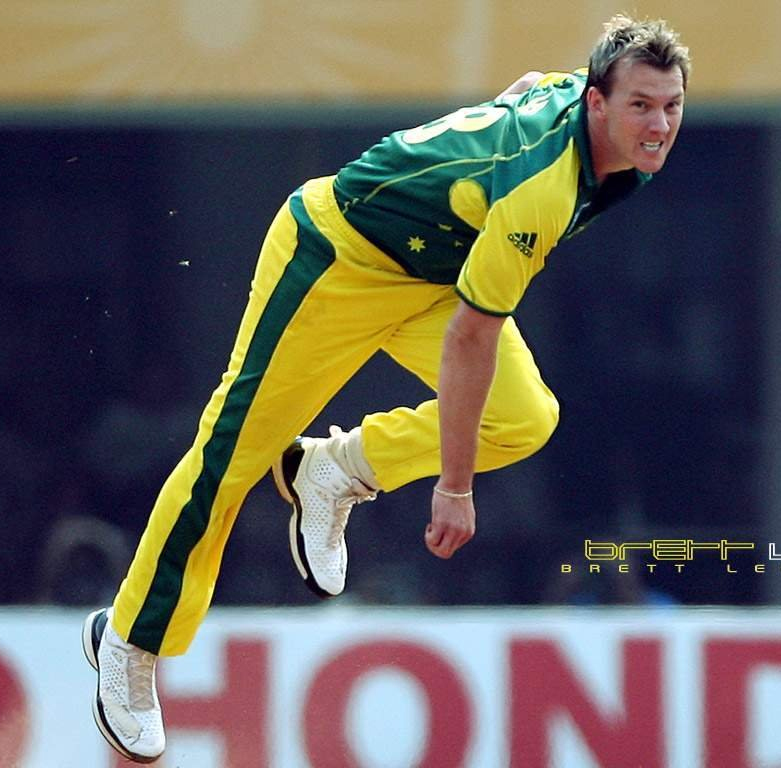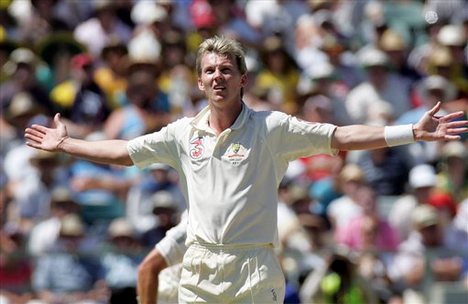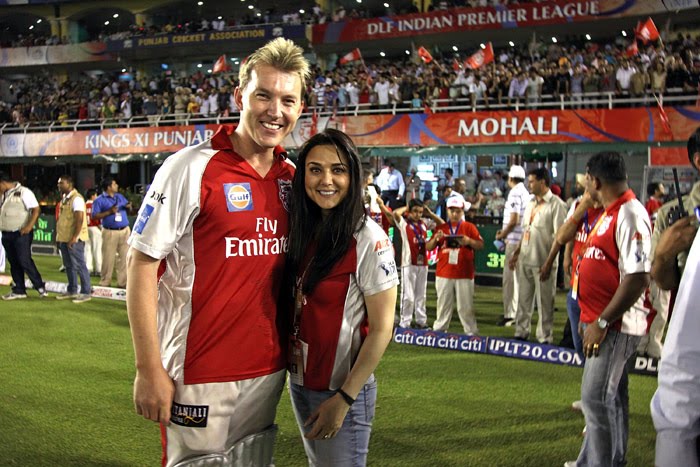Brett Lee – Australia’s superstar yet flawed speedster

Also known as Binga or ‘The Speedster’, Brett Lee was born in Woolongong, New South Wales (NSW) on November 8, 1976. As a result, he too belongs in the elite bunch of cricketers to have gone on to play for Australia after playing for the New South Wales team in Sheffield Shield cricket. But he first played for the Australian U-17 and U-19 teams in 1994, and due to good performances, he was awarded a scholarship to attend the Australian Institute of Sports a year and a half later. It was only in 1997 that he made his debut in first class cricket for NSW against Western Australia, taking 3 wickets in the first innings. Due to his 14-wicket haul throughout the competition, averaging 30 per wicket, he was called up to play for Australia A on the tour of South Africa, which was his first biggest step to playing international cricket.
His form was so brilliant that the national selectors were compelled to pick Lee atleast in the national squad so that he could be kept in the reckoning, if not the national team’s playing XI in Tests. The selectors did so against Pakistan at the beginning of the home summer in 1999 but it was against the Sachin Tendulkar-led India a month later that he actually made his Test debut in the Boxing Day Test at Melbourne, in the process being Australia’s 383rd cricketer to earn the Baggy green cap.
Brett Lee made an immediate impact in the match, picking up a five wicket haul on Test debut which included wickets of opening batsman Sadagoppan Ramesh in his first over, Rahul Dravid, and tail end batters such as the ‘Bombay Duck’ Ajit Agarkar, Javagal Srinath and wicket-keeper batsman M Prasad. While in the second innings, he got the better of Dravid again to help Australia win by 180 runs and take the series 2-0. Therefore, by the end of the series he had picked 13 wickets in his first two Tests, at a miserly average of 14.15.
Binga thus became the recipient of the first ever Donald Bradman Young Player of the Year Award in early 2000 at the Allan Border Medal ceremony. That was at the time when he also made his ODI debut in the traditional home triangular series, against Pakistan at The Gabba, Brisbane. He did not make as much of an impact in ODIs as compared to Tests, although he finished with 16 wickets in 10 matches of the series, which Australia went on win by defeating Pakistan in the final.
But in Test cricket, he finished with 42 wickets in his first three Test series, making him own a record of having the most number of wickets by any Australian bowler in seven Tests, till date. However, a perennial injury on his lower back reoccurred as well as a rare injury on his right elbow was sustained, for which he had to be sidelined for close to six months of all forms of cricket. This was the first of Lee’s many injuries, which have been the biggest roadblock in his international career.
Brett Lee’s mixed run in England
He made a comeback in the Ashes Series in the summer of 2001 in England, a country which has not been a good host throughout the year, as he suffered the worst traumas of his life out here. He managed only 9 wickets in 5 Tests, and it was a prelude to disasters in 2005 and 2009. Come 2005 and Lee was the man who remained at the other end, while England celebrated a narrow 2 run victory in the second Test at Edgbaston, Birmingham. Binga was so shattered by the defeat that it had to take a great act of sportsmanship from his current friend and former England all-rounder Andrew Flintoff to console him on the field, despite the intense rivalry with which the match was played. In fact, it is said that it was after a whole-hearted chat with Flintoff that Lee sadly decided to quit Test match cricket on the eve of the first Test of the 2009 series following a left side strain and a sore rib, so that he could focus more on ODI and T-20 cricket for prolonging his career and his value for Australia.
Although it is a different story for Lee when it comes to play ODIs in England. He picked 10 matches played against England and Pakistan altogether in June 2001, with Australia going on to win the tri-series. Four years later, and he improved with his showing in the matches against England and Bangladesh where he picked 14 wickets in 8 games as the team shared the NatWest series with England following a tied final at Lords while defeating England in the 3 match NatWest Challenge ODI series, which was perhaps a sort of a marketing gimmick used by the England and Wales Cricket Board for a build-up to the upcoming Ashes series. While in the 2009 ODI series against England, he appeared in five of the seven matches and finished with 12 wickets in the series, for which Lee was praised equally by the Australian and the English media for staging a strong comeback after suffering from an injury which made him retire from Test cricket.
Brett Lee’s topsy-turvy ride in Tests
Brett Lee has never cemented his place in the Test team for a ‘long’ period of time, mainly due to injuries which cannot make cope with the rigours of five day cricket. Or, the fact that his form has never been up to the mark, as per the standards traditionally set by the Australians for their bowlers to perform.

Following the 2001 Ashes in England, Brett Lee played in all the Tests of the home summer against New Zealand and South Africa in which he finished with 23 wickets in 6 Tests. While in the return series in South Africa, Brett Lee was mediocre since he picked only 10 wickets in the 3 Tests played there but that was good enough for Australia to win an away Test series.
However, Brett Lee struggled against Pakistan in the 3 Tests in late 2002 which saw him dropped for the first two Ashes Tests at home. But he returned strongly in the next three Tests, in which he picked up 13 wickets as Australia won the series 4-1 and the Ashes remained at home.
2003 was a relatively good year for him although 29 wickets came in 8 Tests against the West Indies in the West Indies and minnows Bangladesh and Zimbabwe at home. However, Brett Lee suffered from a torn abdominal muscle which made him unfit to play the Brisbane and Adelaide Tests against India. He did not make a successful return this time around, in the final two Tests, as he picked only 8 wickets at a disastrous average of 59.50. He had the worst bowling average and economy rate amongst each member of the Australian attack, which was without the services of Shane Warne and Glenn McGrath.
Brett Lee was replaced by the resurgent Michael Kasprowicz, as he had to sit on the sidelines for the next 18 months which saw Australia win series in Sri Lanka and India. However, Kasprowicz struggled for form prior to the Ashes 2005 in England and Lee made a grand return to the big stage, also due to the pressure built on the Australian selectors by the media. The first Test at Lords was where he took the new ball with McGrath but throughout the series he averaged 40 despite picking 18 wickets. He proved his abilities with the bat in Birmingham and Manchester, as he averaged a stunning 26.33.
But the home summer saw Lee pick 28 wickets in a span of 6 Tests against West Indies and South Africa and that was followed by 13 wickets in 3 Tests in South Africa, being only second behind Shane Warne’s 14 wicket haul. Australia won 3-0, and Lee had now become once again one of the team’s bowling spearheads in case Glenn McGrath was absent.
His role was that of a supporting actor though in the 2006 Ashes at home, where he picked 20 wickets in 5 Tests, relatively lower than his other bowling colleagues. But he had to usurp responsibility in the next home summer against Sri Lanka and India, being the senior most bowler of the team. In a span of 6 Tests, he struck gold, picking as many as 40 wickets at an average of 20.04, as Australia beat the Lankans 2-0 and India 2-1.
He continued to be in good shape, picking 19 wickets in the 3 Tests in the West Indies to follow which helped the Australian side being stable in their period of transition. But the beginning of the end in Tests was incidentally on the tour of India, where he caught a stomach virus and there were rumours that all was not well between him and captain Ricky Ponting as he finished with 8 wickets. He did pick 12 wickets in two Tests against New Zealand at home, but his pace had plunged big time.
The last Test of his career was against South Africa in Melbourne in December 2008 in which he struggled with foot and ankle injuries. This was such a sad way to end a promising Test career in which he appeared in 76 matches, picked up as many as 310 wickets which is the fourth highest by any Aussie bowler in Tests averaging 30.81, with 10 five wicket hauls.
Brett Lee as Australia’s top bowler in ODIs
For the majority of his career, Binga had to stay under the shadow of fast bowling colleagues such as the legendary Glenn McGrath and the fiery Jason Gillespie in both formats of the game. Yet, he reveled in the role as Lee was an additional burden on the opposition to face due to his outstanding level of consistent pace throughout his spells. If a team thought that they got the better of the opening bowlers, their task was half done as Lee was there backing them.
In the first three years of his ODI career, spanning from January 2000 – January 2003, Lee had picked 88 wickets in 48 matches, amongst which he had won the man of the series award in the triangular series at home prior to the World Cup against England and Sri Lanka, where his role was instrumental in Australia’s title win. These were amazing figures for a relatively inexperienced bowler who was said to have pace and nothing else in him. This made him one of the most feared bowlers though in world cricket, and come the 2003 World Cup and Lee was ready to actually prove his standing.
He finished second in the highest wicket-takers list behind Sri Lanka’s legend Chaminda Vaas, with 22 wickets at an average of 17.90, being easily Australia’s most successful bowler in the competition. One of his unforgettable spells of bowling was the 5/42 he picked in 9.1 overs against Trans-Tasman rivals New Zealand in a Super Six game, which helped Australia in successfully defending a modest total of 208 and renewing their vigour in the World Cup campaign. While he also bowled the second fastest delivery ever in World Cup cricket, that of 160.7 km/hr against England at Port Elizabeth in a group game, thriving in the South African conditions which have generally been conducive to the skill called fast bowling.
He went to play a small amount of cricket for the rest of the year following the tour of the West Indies right after the World Cup, where he picked 11 wickets in the 6 ODIs he played there. While he picked a 4-wicket haul in a game against Bangladesh at Cairns in August 2003, before suffering from a torn abdominal muscle, which ruled him out for the triangular series in India featuring the hosts and New Zealand. That was Australia’s last ODI assignment for the year 2003, before the customary triangular series at home involving India yet again and minnows Zimbabwe.
In that series, he picked 12 wickets in 8 matches as he involved in another tournament win for Australia at home. However, he again suffered from an ankle injury on the tour of Sri Lanka and had to return home after playing only three ODIs against the host nation. It was only in the autumn of 2004 that he returned to play in the tour of Europe which involved playing in Netherlands and the ICC Champions Trophy in England.
However, he began 2005 in style following 13 wickets in 7 matches in the home triangular series which involved West Indies and Pakistan as Australia’s dominance in their own backyard continued. And he starred in the following 5 match ODI series in New Zealand, with Lee picking up 10 wickets and in the last ODI, he bowled his fastest delivery till date, that of an astounding 160.8 km/hr. The year went by smoothly for Lee with 14 wickets in England and 8 against the powerful ICC World XI at home in 3 games.
However, in January 2006 Brett Lee was officially declared the Worlds No.1 bowler in ODI cricket as per the ICC rankings. He finished with 15 wickets which included a 5-wicket haul against South Africa, being second behind the emerging Nathan Bracken in the triseries against Sri Lanka and South Africa at home. An average tour of South Africa followed but he was back in his elements for the remainder of the year with 4 wickets in 2 games in Bangladesh and 12 wickets in 3 games in Malaysia in September 2006, which won him the man of the series award. He played a crucial role in Australia finally winning the ICC Champions Trophy in India with 6 wickets in 5 games.
The form was carried on at home against England and New Zealand after the Ashes, but again fate was cruel to Lee in the form of another elbow injury which ruled him out of the 2007 World Cup in the West Indies. He made a return though, fit and fresh in the T-20 World Cup in South Africa and the subsequent ODI series in India towards the end of the year. But his best came back in the home season against India and Sri Lanka at the beginning of 2008 when he picked two 5-wicket hauls vs. India in his tally of 16 wickets throughout the series, although Australia did not win for the second year in a row at home.
He played 3 ODIs in West Indies during the month of May, but again faced a minor injury to be ruled out of the series and played one day cricket only after a year, once again on the tour of England. Lee had a better Champions Trophy in South Africa in September 2009, rather than in India the last time, picking 6 wickets in 4 matches as Australia successfully defended their title. But Lee seemed to have a recurring injury in many of his body parts due to the pressure he exerts on himself due to his utmost reliance on pace, and that denied him to play ODI cricket until January 2011 when he turned up to play against England in a 7 match ODI series at home, prior to the World Cup.
Australia considered Lee as their bowling spearhead going into the World Cup 2011 in India following 11 wickets against England in 6 matches and an inexperienced bowling attack, comprising the likes of Mitchell Johnson, Shaun Tait, Doug Bollinger and Jason Krejza. He finished with 13 wickets in 7 games, the highest amongst the Australian bowlers, but could not allow Ricky Ponting to win a third World Cup as captain following the quarterfinal exit to India at Ahmedabad.
Lee’s qualities as a fighter was evident in the match when he continued to bowl and field vigorously for the team despite suffering a major cut on his cheek, with blood profusely coming out. The image is likely to be forever etched in the minds of those fans who watched the match. While his four wicket haul against Pakistan made Australia lose with some dignity in the end at Pallekele in the group stages, as he kept Australia in the hunt to defend a total of 180 successfully.
The rest of 2011 was average for Lee as he could only add nine wickets to his current career tally of 357 ODI wickets in 205 matches at an average of 22.90 at an economy rate of 4.70, with his best being 5/22 against South Africa in Melbourne in 2006.
Brett Lee’s affinity towards India
Brett Lee has always loved touring India, whether professionally or for personal reasons.

He first visited the country in 2006 during the ICC Champions Trophy, and recorded a duet with famous female singer Asha Bhosle called You’re The One For Me, which topped the song charts in countries such as India and South Africa for several weeks. He seemed to fall in love with the country, especially the city of Mumbai praising it publicly.
He also has a craving for Indian food and has learnt a bit of Hindi over the four years of playing the Indian Premier League, with words such as ‘Namaste’ in his vocabulary. Besides, he has a huge fan following in India, definitely the highest for any Australian cricketer of the modern era due to his generally good on the field and gentlemanly off the field behavior. While his eternally young looks and flashy smile makes females drool over him, although he has a son too and had been married for three years.
When it comes to the IPL, Binga has taken the tournament as a platform to hone his T-20 skills by turning out for the Kings XI Punjab in the first three years, which also explains his closeness towards Bollywood actress Preity Zinta, the owner of the team.

And Kolkata Knight Riders from the 2011 season onwards, playing once again in a team owned by a Bollywood actor. SRK and co. thought that Lee would be their bowling spearhead due to his experience and fitness expected to be decent enough to feature in atleast 7 weeks of the competition.
India also reminds him of his favourite hobby, which is playing the guitar. He is a part of a professional rock band, Six and Out which also involves his elder brother and former Australian cricketer, Shane Lee. He is contemplating the decision to come regularly to the country to give live performances with the band, and in that pretext also visiting the country yet again. Though this will be after his retirement from all forms of the game.
While he has tried his hand in Bollywood with a special appearance in the film ‘Victory’ released in 2008, starring rookie actor Harman Baweja. Lee played himself in the movie.
Brett Lee’s present and the future
Binga clearly does not seem to have much cricket left in him as his broken foot is the second injury Lee has suffered in the last four months. He will have to sit out for the entire triangular series against India and Sri Lanka, which will be the second ODI series on the trot he will miss as he was also absent from the 3 match series in South Africa in October 2011.
Lee will definitely be in Australia’s plans atleast for the next 12 months or so, as the team needs him to mentor the bowling attack considering his experience. But an age of 35 does not help his cause at all and his desire to reach the landmark of 400 wickets may remain unfulfilled although he had given up Test cricket 30 months ago to focus on ODIs and T-20s.
He does have a future with the Kolkata Knight Riders in the IPL for two more years subject to his fitness, although his style of bowling has changed in T-20s from being a wicket-taker to a bowler who can contain runs with his pace. While he had a successful outing for his home team, Sydney Sixers in the recently concluded Big Bash, where he thrived in wicket-taking conditions as his pace continued to make batsmen nervous. He was the key and ofcourse one of the star players to help his team win the inaugural competition, despite losing out the services of their captain Brad Haddin.
Brett Lee could have ended as Australia’s greatest bowler ever with more than 650 international wickets to his name. But bowling at an extreme pace comes at a huge cost, which is a short and a rather incomplete career. It may be entertaining for fans but not so much for the team whose needs are more important to satisfy.
Dennis Lillee, the former Australian quick bowler, may rate him highly due to the fact that he empathizes with him better than anyone else. But if one is asked to rank Lee as a bowler, he may have a 50% chance of featuring in the greatest ODI bowlers of all-time list but will never feature as one of the finest Test bowlers.
However, he will surely be renowned as one of the world’s most fastest bowlers and the most popular one, despite competition from the likes of team-mate Shaun Tait and Pakistan’s Shoaib Akhtar.

Leave a Reply